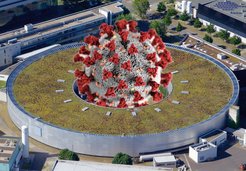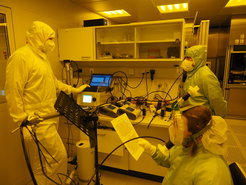Synchrotrons accelerate corona research
Researchers from Göttingen and Mainz use short-wavelength photons to study distribution of aerosol particles during singing, talking or coughing

The main spreading route of SARS-CoV-2 is airborne transmission via virus particles found in the breath of infected persons. In the collaborative research project, samples of aerosols emitted during breathing are first collected in the MPIDS cleanroom using a face mask specially designed for this purpose. "Special filters on the full-face masks and measurements in the cleanroom create controlled measurement conditions and largely eliminate particles which are already in the air," says Prof. Bodenschatz, director at MPIDS, explaining the experimental setup. The samples are subsequently examined and analyzed at the MPIC using specific microscopic and spectroscopic methods. For this, the team of Dr. Christopher Pöhlker also collaborates with Dr. Markus Weigand from the Institute of Nanospectroscopy at Helmholtz Zentrum Berlin.
"Spectroscopic analysis using X-rays at the BESSY II synchrotron helps us obtain an accurate picture of the virus at the molecular level to better understand the transmission of pathogens in everyday life," Pöhlker describes. In order to develop effective vaccines and drugs against the virus, such a molecular understanding of the transmission pathways is essential. However, a classic light microscope is not sufficient to observe the virus particles: They are smaller than the wavelength of light itself and thus elude optical observation.
Rapid progress thanks to large-scale research facilities

However, the use of shorter wavelength radiation, such as X-rays, provides a remedy: With the help of the synchrotron, extremely brilliant X-ray light can be generated, which allows the virus to be imaged with atomic precision. This also shows the advantage of the research infrastructure in Germany and with German participation, which has been established for decades: In addition to BESSY II at Helmholtz-Zentrum Berlin (HZB), there are other similar large-scale research facilities such as the PETRA III and FLASH synchrotron light sources at the German Electron Synchrotron (DESY) in Hamburg, the European XFEL in the Hamburg area or the ESRF in Grenoble, France.
The heart of such a synchrotron is a particle accelerator: it accelerates electrons to nearly the speed of light. Special magnets deflect the electrons from their trajectory; when they brake, they lose energy in the form of light. These photons, which cover a wide range from infrared to X-ray, are then used to study chemical processes, cells and molecules, the dispersion of aerosol particles or the extent of damage to the lung tissue of COVID patients.
"The special thing about such dedicated research infrastructure as BESSY II is: a large community of users from research institutions, universities and even industry can study their samples using state-of-the-art measurement methods. It is a huge advantage, especially for corona research, that this infrastructure is available" says Prof. Dr. Jan-Dierk Grunwaldt (KIT), chairman of the Committee Research with Synchrotron Radiation (KFS).
Right after the genome of the novel coronavirus SARS-CoV2 became known in early 2020, the first measurements of virus molecules started at German synchrotrons. Through a special fast-track procedure in the organization, researchers were granted measurement time at short notice, which normally has to be requested several months in advance. This allowed a large number of different projects to be carried out, as was the case with the investigations by scientists from the Max Planck Institutes in Göttingen and Mainz.
The next measurements on the scanning X-ray microscope MAXYMUS to study aerosol particles are planned for November 2021. Further information can be found here.
(Press release of the Committee Research with Synchrotron Radiation (KFS) / Edited by MPI for Chemistry & MPI for Dynamics and Self-Organization)

